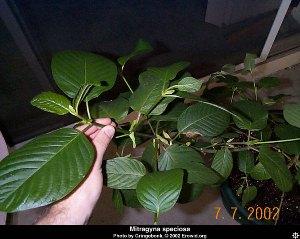By psmith August 08, 2012 (Issue #746)
The prohibitionist impulse is strong. When confronted with a newly encountered psychoactive substance, there are always special pleaders to sound the alarm and politicians willing to reflexively resort to the power of the ban.
Whether it is something with serious potential dangers, like the “bath salts” drugs, or something much more innocuous, like khat, the mild stimulant from the Horn of Africa, doesn’t seem to matter; the prohibitionist impulse is strong.
 Kratom is a substance that falls on the more innocuous side of the psychoactive spectrum. It is the leaves of the kratom tree, mitragyna speciosa, which is native to Thailand and Indonesia, where the leaves have been chewed or brewed into a tea and used for therapeutic and social purposes for years. According to the online repository of psychoactive knowledge, the Vaults of Erowid, kratom acts as both a mild stimulant and a mild sedative, creates feelings of empathy and euphoria, is useful for labor, and is relatively short-acting.
Kratom is a substance that falls on the more innocuous side of the psychoactive spectrum. It is the leaves of the kratom tree, mitragyna speciosa, which is native to Thailand and Indonesia, where the leaves have been chewed or brewed into a tea and used for therapeutic and social purposes for years. According to the online repository of psychoactive knowledge, the Vaults of Erowid, kratom acts as both a mild stimulant and a mild sedative, creates feelings of empathy and euphoria, is useful for labor, and is relatively short-acting.
Of course, any psychoactive substance has its good and its bad sides, but kratom’s downside doesn’t seem very severe. Erowid lists its negatives as including a bitter taste, dizziness and nausea at higher doses, mild depression coming down, feeling hot and sweaty, and hangovers similar to alcohol. There is no mention of potential for addiction, and while fatal overdoses are theoretically possible, especially with its methanol and alkaloid extracts, in the real world, ODing on kratom doesn’t appear to be an issue. No fatal overdoses are known to have actually occurred.
On the other hand, some of kratom’s alkaloids bind to opioid receptors in the brain, making it an opioid agonist, and it is now being sold in the West and used to treat pain, depression, anxiety, and opiate withdrawal. Sold in smoke shops, herbal supplement emporia, and on the Internet, it is now apparently being lumped in with synthetic cannabinoids and the “bath salts” drugs by treatment professionals, law enforcement, and others who make a habit of searching for scary new drugs.
Arrests for kratom possession have jumped in recent years, from more than 1,200 in 2005 to more than 7,000 in 2009, even though the Thai Office of the Narcotics Control Board recommended to the Justice Department in 2010 that it be decriminalized because of the lack of any perceivable social harms.
In the US, the DEA added kratom to its list of drugs of concern in 2010, although that doesn’t mean that a federal ban is necessarily imminent. Salvia divinorum, for example, has been a drug of concern for more than a decade now, with no action taken. But while the feds haven’t acted, there were efforts to ban kratom in several states in the US this year, although only Indiana actually succeeding in outlawing it. In Louisiana, age restrictions were placed on its purchase.
The experience of Iowa, where legislation to ban kratom is still pending, is illustrative of how bans are created. The Iowa effort happened after state Rep. Clel Baudler (R) heard about kratom on a radio program. Within two hours, he was moving to ban it.
“Kratom is a hallucinogen, addictive, and can be life threatening,” he said at the time, in complete contradiction of all that is actually known about kratom.
It’s not just states that are considering bans on kratom. Pinellas County, Florida, was about to enact one this week, but the prohibitionist bandwagon hit a bump in the road in the form of perennial drug war gadfly Randy Heine, owner of Rockin’ Cards and Gifts in Pinellas Park, who told the Chronicle he had been selling kratom in his store since 1981.

Randy Heine
Seeing what was coming down the pike, Heine alerted the Kratom Association, a group of users, producers, and vendors dedicated to keeping kratom legal, who flooded county commissioners with emails. He also addressed the commission itself. “I have been selling kratom for over 30 years out of my store on Park Blvd. I challenge anyone to find any problem originating from my store selling kratom,” he wrote in a letter made available to the Chronicle. “Do not lump in synthetic chemicals with an organic plant material. This is like comparing apples to oranges. I would like to see kratom be sold only to persons over the age of 18, similar to the proposal being made in our sister state of Louisiana.”
In the conservative county, Heine also appealed to the ghost of Ronald Reagan in his letter to commissioners. What riles up the Reagan in him, Heine wrote, is “growing the bureaucracy by creating another board to regulate what I and others do in privacy of our own homes.”
“I got letters back from two of the commissioners,” said Heine. “They read my Ronald Reagan letter out loud, and one of the GOP commissioners thanked me for sharing my thoughts. The commission has now deferred this item so we can take a closer look at the issues involved.”
Many of his kratom customers are using it as an opiate substitute, he said.
“We have a drug rehab place here, and my feeling is that a lot of their clients are purchasing kratom instead of methadone. It’s competition; I’m taking away money,” he said. “Some of my customers say methadone is worse than heroin and keeps you addicted. Kratom weans them off heroin. A lot of them say they just do less and less kratom until the craving stops. I have a couple of senior women who say they’re tired of taking prescription pills, that they make them nutty, and kratom works for them.”
Chronicle readers may recall that Pinellas County is where a drug reform-minded upstart Democratic candidate for sheriff is taking on either the scandal-plagued Republican incumbent sheriff or his challenger and predecessor, former Sheriff Everett Rice (the GOP primary is next week), whose supporters on the council were pushing the kratom ban. That Democrat, Scott Swope, is so good on drug policy that his candidacy persuaded Heine to drop his own bid for the sheriff’s office.
While Heine is currently bedeviled by the effort to ban kratom, as well as an associated effort to force smoke shops to put large signs on their doors saying they sell drug paraphernalia, the Swope candidacy has him hoping for better times ahead.
“Swope can win,” he exulted. “We finally have a candidate who is talking about marijuana. Even the Republican candidates are now saying they wouldn’t bust people for marijuana. When I was still a candidate, I went to many forums to talk about pot, and the media started asking these guys about it. Scott won’t arrest people for personal use.”
Whether it’s relatively unknown substances like kratom or now familiar substances like marijuana, the battle lines are drawn in what is ultimately a culture war. On one hand, the forces of fear and authoritarianism; on the other, the forces of free inquiry and personal liberty. It’s been a long war, and it isn’t going to end anytime soon, but perhaps now there are hints that the correlation of forces is changing.
Stopping unnecessary prohibitions before they get started is part of the struggle; undoing entrenched prohibitions with powerful interests behind them is another part of the struggle, but even though the substances are different, it’s the same struggle.
View Source







